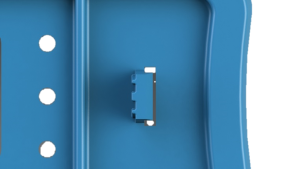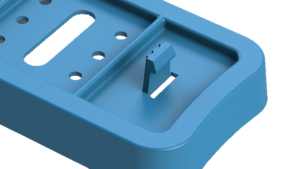- BY Rex Plastics
- POSTED IN Product Development
- WITH 1 COMMENTS
- PERMALINK
- STANDARD POST TYPE
Rex Plastics Product Development
Plastic Part Design Fundamentals
Draft Angle
In this edition of our Product Development series, we’ll briefly overview a fundamental concept for plastic part design, ‘draft angle’. Draft angle, or ‘draft’ is essential for all plastic injection molded products. It facilitates the removal of the part from the mold. Adding draft angles will also improve cosmetic appearances of plastic molded products by reducing drag marks. The amount of draft needed is part-specific. Draft angles should be added to any face that is parallel to the mold opening/closing. The images below offer examples of undrafted vs. drafted plastic molded parts:

The undrafted part (shown above) includes straight lines for all faces. In the image below, the vertical faces of the plastic part have a slight draft angle applied to the design.

Pass Core Shutoff
A pass core shutoff is when metal from both sides of the mold slide together and create a seal off. Because the mold is constantly wearing every cycle, a minimum of 3 degrees of draft is required on all sliding faces. This higher draft angle increases tooling life and prevents galling.


Remember, for mold shutoff design apply a minimum 3 degrees of draft.
Draft Guidelines
Here are some rough guidelines to follow:

The guidelines associated with the amount of draft required will vary with geometry and other part characteristics (i.e. surface texture requirements), but in general, the more the better.
Learn More
Browse additional examples of plastic injection molded parts with draft angles in our gallery. Interested in developing a plastic product? Learn about our Prototyping and 3D Printing Services, here.



The blog “Fundamentals of Plastic Part Design – Part 2: Draft” provides a highly detailed and professional explanation of draft angles, a critical aspect of plastic part design. It effectively communicates why draft is essential for improving part ejection and overall production efficiency. The clear examples and focus on practical applications make this post particularly useful for engineers and designers. Thank you for sharing such valuable information, and I hope to see more in-depth discussions on other design principles in future posts!